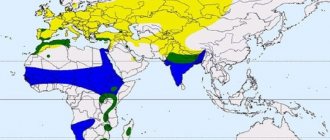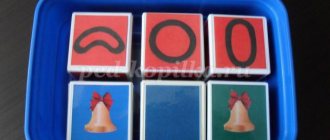Summary of speech therapy lesson “Migratory birds”
Date______________ Class________
Lesson No.___________
Topic: Migratory birds
Correctional and educational goals: — Clarification and systematization of children’s knowledge about migratory birds. — Expanding vocabulary on a lexical topic, — Improving the grammatical structure of speech.
Correctional and developmental goals: - Development of visual, auditory attention, logical thinking. — Development of general and fine motor skills. — Formation of skills of cooperation, independence, initiative.
Correctional and educational tasks: - Fostering love for the animal world.
Equipment: cards with images of wintering and migratory birds, colored pencils, pictures of migratory birds, workbooks.
Progress of the lesson
1.Finger gymnastics.
Tili-teli, tili-teli, (Waving their palms).
The birds flew south.
The squirrel flew away -
Gray feather. (Fingers on both hands are bent alternately, starting with the little finger of the left hand).
Lark, nightingale
We were in a hurry, who's quick?
Heron, swan, duck, swift,
Stork, swallow and siskin.
Everyone got ready and flew away (Waving their palms).
They sang sad songs. (Use the index and thumb to make a beak, “The birds are singing”).
2. Articulation gymnastics.
“How a tongue saved a crow from a cat.”
It was a warm autumn day. One day, returning from the store, Tongue sat down on a bench and began to admire nature. Suddenly he heard an old crow croak: “Kar-kar-kar!” He looked around (exercise “Watch”)
and crumbled a small bun. Suddenly a large black crow landed very close to him.
She folded her wings and began to walk proudly. Nodding its head up and down, the crow picked up bread crumbs from the ground (exercise “Swing”).
Tongue was very amused by this proud bird, and he began to imitate her (exercise “Duck beak”: pull in your cheeks and hold them with your teeth, move your lips like a “beak”).
Before the crow had time to pick up all the crumbs, an angry cat appeared from behind the tree
(ex. “Angry cat”).
The crow got scared and flew into the sky and began circling for a long time
(exercise “Jam”: lick your lips from left to right).
The tongue, on the contrary, was not afraid.
He poured fresh milk into a saucer for the cat (exercise “Cup”)
and let her lap it up a little (lap the milk like a cat).
Very soon the cat drank all the milk, and the saucer turned out to be empty (exercise “Cup”).
Having washed her paws, ears and face
(exercise “Jam”),
the cat climbed a tree and fell fast asleep.
A little later, the crow sank to the ground and finished off the remaining crumbs (exercise “Swing”).
When Tongue returned home, he recalled with a smile how he saved an old crow from an angry cat (exercise “Smile” - “Angry Cat”).
3. Breathing exercises “Bird fly”
Place the paper bird on your palm. We take a short nasal inhalation and a long, targeted oral exhalation. As a result, the bird flies from the palm. The exercise is repeated 4-5 times.
4. A conversation about migratory birds.
Speech therapist: Guys, what can you call in one word the birds that we named while doing finger exercises? (Migratory birds).
-Why are they called migratory? (They are called migratory because they fly to warmer regions for the winter).
-Why do they fly to warmer climes? (They are afraid of the cold, cannot get food, water bodies freeze)
-What stories and fairy tales do you know about migratory birds? (“Thumbelina”, “Geese-Swans”, “The Fox and the Crane”, “Grey Neck”, “The Ugly Duckling”).
5.
“Make no mistake.”
The speech therapist invites the children to sit at the tables.
On the tables are cards depicting migratory and wintering birds.
Speech therapist: “You need to circle all the migratory birds with a red pencil and justify your action.”
Child: “I circled the swallow because the swallow is a migratory bird.”
“I circled the crane because the crane is a migratory bird.”
6. Game “Where is the bird?” »
Speech therapist: I will move the bird, and you will tell me where it is now. “Where did the starling fly from? "What did the starling fly up to? »
7. Game “Name the parts of the bird’s body.”
Working with the mnemonic table “Migratory Birds”.
Speech therapist: Guys, look at the picture of birds, tell me what body parts they have. We answer with a full sentence.
Birds have a head. Birds have two wings.
Birds have two legs. Birds have a tail.
Birds have a beak. The body of birds is covered with feathers.
6. Game "Find the sound".
The speech therapist invites the children to come to the board. On the table, near the board, there are pictures depicting migratory and wintering birds.
Speech therapist: Guys, each of you must choose a migratory bird and attach it to the board. (children complete the task).
Speech therapist: Now you need to name each bird, determine the first and last sound in the word and divide the word into syllables.
1st child: This is a stork. The first sound in this word is [A]. The last sound is [T]. The word AIST has two syllables.
2nd child: This is a cuckoo. The first sound in this word is [K]. The last sound is [A]. The word CUCKOO has three syllables.
3rd child: This is a heron. The first sound in this word is [C]. The last sound is [I]. The word HERON has two syllables.
7. Work in notebooks
Speech therapist: Now let’s label our birds and highlight the sounds that we were looking for.
8. Summary of the lesson.
The speech therapist asks the children what migratory and wintering birds are called and why, how to determine the first and last sound in a word.
Summary of GCD in the preparatory school speech therapy group “Birds of Migratory”
Transcript
1 Municipal budgetary preschool educational institution “Kindergarten 365”, city of Samara The summary of the educational activity in the preparatory school speech therapy group “Migratory Birds” was prepared and conducted by a teacher-speech therapist MBDOU d/s 365 Kalyuzhina E.Yu. Samara, 2015.
2 GCD topic. Migratory birds. Developer: Elena Yuryevna Kalyuzhina, teacher-speech therapist of the first qualification category at MBDOU kindergarten No. 365. Samara Age of children: 6-7 years old. Date: March 2015. Goal: to clarify children’s knowledge about spring and migratory birds. Objectives: 1) correctional and educational: expanding children’s ideas about migratory birds, their appearance, and way of life; learning to speak in detail; teaching the formation of complex adjectives; teaching the formation of prefixed verbs; 2) correctional and developmental: development of the ability to answer questions fully; development of coherent speech; development of verbal and logical thinking; 3) correctional and educational: fostering a caring attitude towards nature; education of moral qualities. Organization of the educational environment: For motivation for GCD: audio recording “Voices of Birds” For conducting GCD: subject pictures, globe, illustrations of bird flight. Preliminary work: -teacher: development of notes, production of manuals, selection of speech material and subject pictures on the topic of GCD;
3 - with children: bird watching while walking; reading poetry, stories about birds; looking at illustrations of different types of birds. — with parents: consolidation of speech material. Forms of organizing joint activities: game, conversation, independent activity, exercise for the development of general and fine motor skills, self-analysis. Carrying out GCD Motivation: Children play on the carpet. Play the audio recording “Bird Voices”. Speech therapist: - Guys, what sounds are heard around? Let's listen carefully. Speech therapist: - Whose voices were heard? — What mood did the singing of birds make you feel? — What birds fly in in the spring? -What are these birds called? - Why are they called migratory? — What migratory birds do you know? (Children's answers) Implementation of activities. 1. Game "4th odd". Pictures of birds are hung on the board. - Which bird is the odd one out? Why? (children explain their choice) Swallow nightingale crow crane Magpie stork sparrow pigeon
4 2. Consolidation of knowledge about migratory birds. Speech therapist: Guys, why do you think birds fly away in the fall? (Because it's getting cold, there's nothing to eat). L: — The most important thing is that there is no food for life. You know that in the fall many insects disappear: they either hide or die. If birds feed on insects, then they will have nothing to feed themselves in the winter. — If birds feed on insects, then they are called insectivores. What insectivorous birds do you know? (Children make assumptions) L: - Insectivorous birds: starling, swallow, cuckoo, oriole, nightingale, wagtail. They can be distinguished by their beak: it is straight, elongated or pointed to make it easier to catch insects. The wagtail is one of the most useful birds. She destroys flies and mosquitoes, which she deftly chases in the air. This bird is especially useful in the garden, where it quickly runs around the beds and pecks insects from the ground and plants. — The wagtail is one of the first to fly away, like all insectivorous birds. Then the granivores, that is, those that feed on fruits and seeds, fly away
5 plants. You know them too. Look at the picture of the bunting, siskin, and chaffinch. - Wild ducks and geese and swans fly away later than everyone else. They get ready to travel when water bodies freeze, because they are waterfowl. 3. Game “Say in one word” Speech therapist: - Let's pay attention to the characteristic signs of migratory birds. Each bird has its own. Write a definition for bird using two words. — The stork has long legs. He (long-legged) - The cuckoo has motley wings. She (pied-winged) - The duck has a wide beak. She (broad-billed) - The rook has black wings. He (black-winged) - The starling has a ringing voice. He (loud-voiced) - The swan has a long neck. He (long-necked) - The swallow has a white breast. She (white breasted)
6 4. Game “What the bird is doing.” Speech therapist: - Complete the sentence, changing the word “flies”: 1. A starling in a birdhouse (flies in) 2. A swallow comes to us from across the sea (flies in) 3. A cuckoo from branch to branch (flies) 4. A swan from a nest (flies out) 5. Seagull to the water (flies up) 6. Crane into the sky (flies away) 5. Conversation about birds. Speech therapist: - Guys, how do birds find their way home? (Children make guesses). L: - In flight, they are guided by the stars. And if the sky is overcast and the earth is not visible, then they focus on its vibrations. -Did you know that some birds, such as ducks, fly away in “flocks”, i.e. together. Some birds, such as cranes, fly in a “wedge”, i.e. in the form of a triangle. Other birds line up in a “chain”, i.e. one after another, line up in one line. It depends on the habits of the birds. Birds always have a leader who flies ahead and shows the way. (Children look at the illustrations and draw a “wedge” and a “flock”)
7 6. Physical exercise “Birds” Children bend their fingers for each name of a bird. Sing, sing along, Ten birds are a flock: This bird is a nightingale, This bird is a sparrow, This bird is an owl, Sleepy little head. This bird is a waxwing, This bird is a corncrake, This bird is a starling, A gray feather. This finch, this swift, this cheerful siskin. Well, this evil eagle, Birds, birds, go home. (Children scatter to the sides) 7. Exercise “Continue the sentence, find the reason” - Insectivorous birds are the first to fly away in the fall, because (insects are hiding and they have nothing to eat). — The cuckoo does not hatch its chicks because (it does not build its own nests). - All people love to listen to the nightingale, because (he sings beautifully, bursts into song). — In the spring, migratory birds return because (they need to hatch chicks).
8 8. A story about the wintering places of birds. Speech therapist: - Now we know that migratory birds fly to warmer regions for the winter. People didn't know this before. They noticed that some birds disappear in winter and reappear in spring. Only a little later they learned where migratory birds fly to. How did you manage to do this? Scientists were helped by small rings that they put on the birds’ feet. Each ring had the address where the bird was ringed. (Children look at the illustrations) When someone in another country met a ringed bird, he reported it to this address. This is how we managed to find out where the birds spend the winter. Some birds winter on the Mediterranean coast, others in Africa, and there are also those that fly to Japan for the winter. (Show the flight route of birds on the globe, then the children do it)
9 9. Conversation on an environmental topic. Speech therapist: — Guys, why do you think birds are called man’s friends? (Because they are beneficial) Birds delight us with their singing and chirping. This makes people’s lives happier and more fun. What happens if the birds don't arrive in the spring? An environmental disaster will occur. There will be no one to protect forests and parks from harmful insects. Insects can eat all the vegetation and crops in gardens and dachas. There will be no one to distribute the seeds of berries and plants. Therefore, birds are considered man's friends. They must be protected and taken care of! Reading the poem by Musa Dzhangaziev “Take care of the birds” Don’t touch the swallow! She flies here from afar! She raises her chicks with us, don’t ruin her nest. Be a bird friend! Let the nightingale sing under the window in the spring, And let flocks of doves fly over the expanses of the Earth.
10 10. Summing up. Speech therapist: Guys, our lesson has come to an end. You have learned a lot about the life of birds. Unfortunately, for a very long time man lived with the confidence that he could take everything from nature without giving anything in return. And now, as a result of thoughtless human activity, our planet is dying. Many plants, animals and birds are completely disappearing or are on the verge of survival. That is why people who cannot look at the death of wildlife with indifference have created several volumes of the Red Book, where these plants and animals were listed. They can still be saved. Don't forget that birds are our friends, younger brothers, and we must take care of them and protect them. Literature 1. Petrova T.I., Petrova E.S. Games and activities for the development of speech in preschoolers. M., I.V. Baskakina I.V., M.I. Lynskaya. Speech therapy games M., Repina Z.A., Buiko V.I. Speech therapy lessons. Ekaterinburg, 2005.




